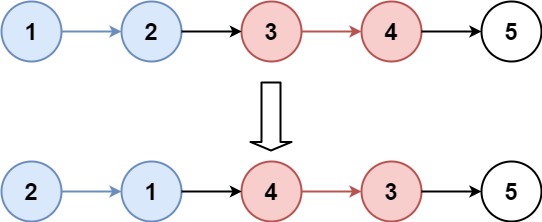Reverse Nodes in k-Group 以K个节点为一组反转链表
Given the head of a singly linked list and two integers left and right where left <= right, reverse the nodes of the list from position left to position right, and return the reversed list.
Given a linked list, reverse the nodes of a linked list k at a time and return its modified list.
k is a positive integer and is less than or equal to the length of the linked list. If the number of nodes is not a multiple of k then left-out nodes, in the end, should remain as it is.
Follow up:
-
Could you solve the problem in
O(1)extra memory space? -
You may not alter the values in the list's nodes, only nodes itself may be changed.

Input: head = [1,2,3,4,5], left = 2, right = 4
Output: [1,4,3,2,5]
就是给你一个链表,k个为一组进行反转,最后不够k的就不反转了,而且k肯定小于表长。
问题
把大象塞到冰箱要几步?
分解问题,
1 首先判断这个链表有没有K个元素
2 开始分段反转
3 判断是否反转结束
虚头法 dummy head+递归
reverseN用来判断从head开始是否足够n个节点进行反转,如果不够就不处理,否则就会调用realreverseN进行反转【realreverseN将从传入的head开始的n个节点进行反转处理】,reverseN返回的是从传入的head开始到第n个节点反转后的头节点。如果reverseN最后返回的节点和p.next是同一节点表示反转结束,否则就要让p.next指向返回的节点,继续N个节点的反转处理。
/**
* Definition for singly-linked list.
* public class ListNode {
* int val;
* ListNode next;
* ListNode() {}
* ListNode(int val) { this.val = val; }
* ListNode(int val, ListNode next) { this.val = val; this.next = next; }
* }
*/
class Solution {
public ListNode reverseN(ListNode head,int n){
ListNode p =head;
int count = n-1;
while(count>0&&p!=null){
p= p.next; count--;
}
if(p==null){ return head;}
return realreverseN(head,n);
}
public ListNode realreverseN(ListNode head,int n){
if(n==1){return head;}
ListNode tail = head.next, p = realreverseN(head.next,n-1);
head.next=tail.next;
tail.next =head;
return p;
}
public ListNode reverseKGroup(ListNode head, int k) {
ListNode ret = new ListNode(0, head),p=ret,q=p.next;
while ((p.next=reverseN(q,k))!=q){
p =q;
q =p.next;
}
return ret.next;
}
}